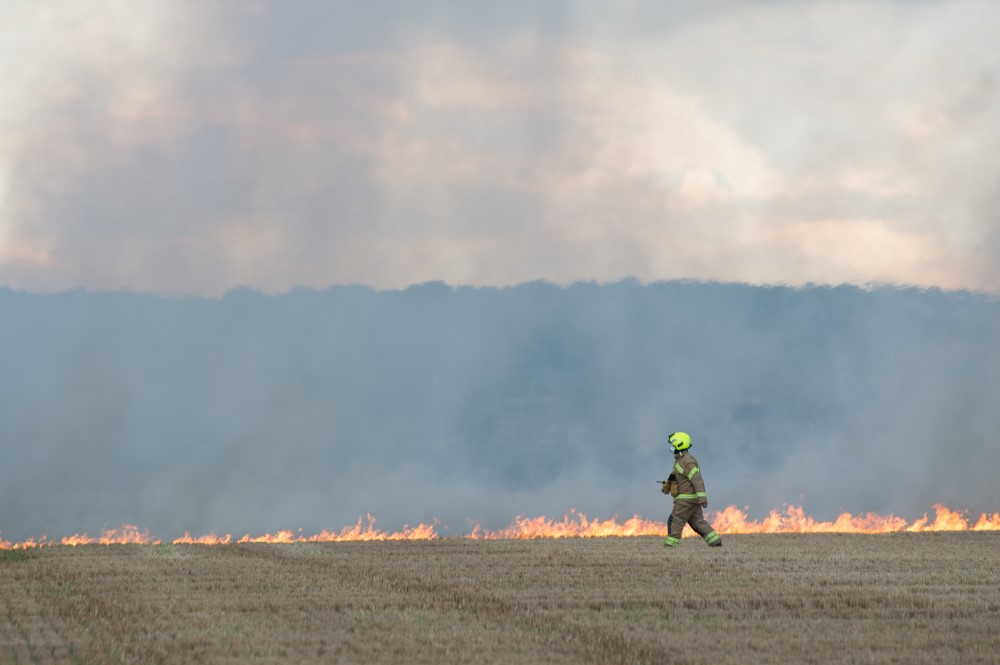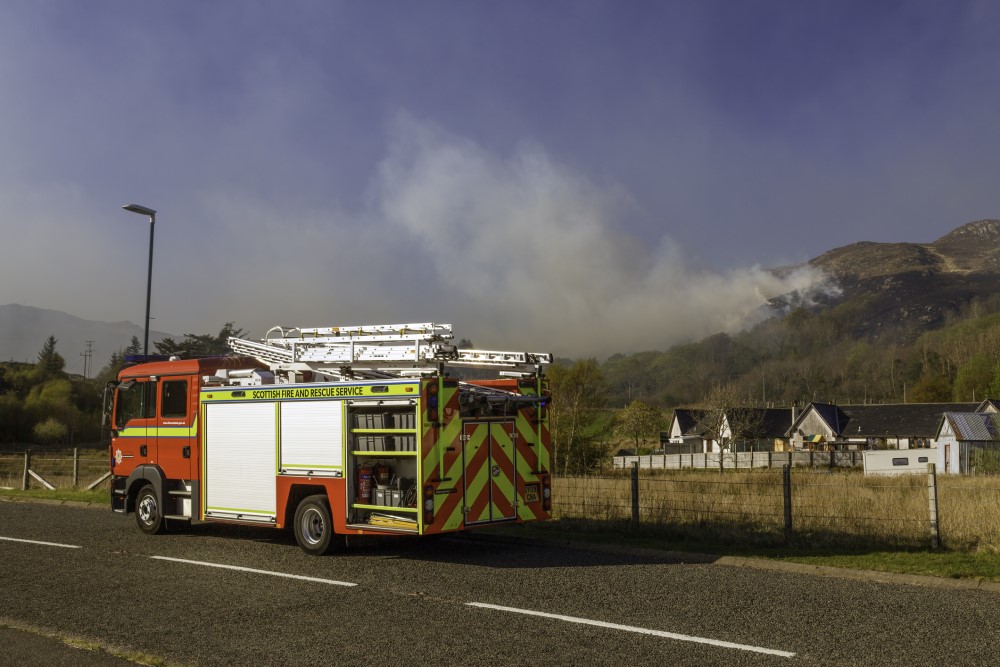Preventing Wildfires on Agricultural Land
5 September 2023
2023 saw the hottest June on record in Scotland with multiple wildfire incidents reported. The wildfire in Cannich, near Inverness, burned for almost two weeks with devastating consequences. As well as destroying ecosystems and threatening lives, homes, and communities, wildfire poses a serious threat to agriculture, potentially resulting in the loss of crops, livestock, and property.
Over the last decade, some European countries have reported as much as a 74% increase in the risk of wildfire. By the end of this century, according to a report from the UN Environment Programme, that risk will increase by a further 50% due to climate change and changes in land use.
However, while extreme weather events such as heatwaves and lightening strike drive that risk up, all available data indicates that between 75% and 90% of wildfire incidents are triggered by humans. Awareness raising, planning, and prevention are key to limiting the potential for damage to the landscape around you, your community, and your business.
Photos courtesy of the Scottish Fire and Rescue Service
How to Protect Your Land from Wildfires
Here are some practical strategies and downloadable tools to help you take proactive steps to protect your agricultural property and significantly reduce the risk of wildfires.
- Gather information and carry out a practical risk assessment for your property. Wildfires are not explicitly covered in existing business fire risk assessments so it’s worth considering them separately. To help you do this you can download our FAS Farm Wildfire Plan and Farm Risk and Resource Map template. We have designed these as guidance documents to help you identify the risks and possible mitigation steps on your property, map risks and resources, and ensure you have important information collated and available when it’s needed most. In the event of a wildfire, the form can be given directly to your local Fire and Rescue Service giving them ready access to important information that can help inform and prioritise emergency efforts.
- Clear vegetation regularly and create firebreaks. One of the fundamental steps in preventing wildfires is vegetation management. You should regularly clear dry and flammable vegetation, such as dead plants, brush, and fallen leaves, from the vicinity of agricultural land. You can also create and maintain firebreaks, which are cleared areas of short grass or no vegetation. These serve as barriers, preventing the spread of fires by acting as containment lines.
- Implementing controlled burns. Controlled burns under expert supervision can be an effective tool for reducing accumulated vegetation and mitigating the risk of severe wildfires.Controlled burns should be conducted under suitable weather conditions, with the knowledge and co-operation of your local Fire and Rescue Service, and in compliance with the Muirburn Code.
- Regular equipment inspections. Farm equipment, machinery, and vehicles can inadvertently start fires, especially during dry conditions. Regularly inspect and maintain agricultural machinery to minimize the risk of sparks or mechanical failures that could lead to fires. Consider fitting vehicles and machinery with spark arrestors to prevent sparks from being emitted into the environment.
- Fire prevention signage. Good signage can play a crucial role in raising awareness and encouraging responsible behaviour. Workplace signage should highlight fire risks, smoking policy, emergency contact information, muster points, and evacuation routes. Consider awareness raising signage for visitors who may access or traverse your land. You can download our printable Wildfire Prevention poster here and visit the Scottish Fire and Rescue service website for a suite of printable leaflets on outdoor and seasonal fire safety for campers, picnics and barbeques. Consider posting signage during periods of high risk and removing it when risk is less severe. Research shows that permanent signage quickly becomes ‘invisible’, as well as being harder to maintain. Remember that while it is sensible to discourage poor behaviour it is often more effective to encourage positive behaviour. If appropriate, consider signposting areas on or near your property where people can camp or picnic safely, for example along the shore of a loch rather than in a wooded area.
- Wild with fire-resistant materials. Construct or consider retrofitting agricultural buildings with fire-resistant materials to help protect against wildfire damage. Use non-combustible roofing materials. Install ember-resistant vents and screens to prevent embers from entering buildings. Maintain a defensible space around structures by clearing vegetation and combustible materials. If you think there is any possibility that asbestos or other hazardous materials may be present in buildings in imminent danger, let Fire Fighters know as soon as possible.
- Safe fuel storage. Particular care is required in planning how and where to store potential fuel sources such as red diesel, heating oil, gas cylinders, dry feed or bedding, or mineral fertilisers containing high levels of ammonium nitrate. Again, during an incident, let fire fighters know as quickly as possible if any high-risk materials are present in buildings or machinery.
- Collaborate with your neighbours. Collaborating with neighbouring farmers and local fire authorities can enhance wildfire prevention efforts. If your area has community fire preparedness programs and fire drills participate in them or consider collaborating to set them up. Stay informed about local fire regulations, burn bans, and emergency procedures. Coordinate with fire and rescue services to conduct training sessions on fire extinguisher use and basic firefighting techniques.
- Identify high-risk periods. Be aware of particular periods of risk. It’s easy to identify periods of risk when there is a prolonged period of hot, dry weather during summer, but did you know that wildfires are just as likely when there is a prolonged period of cold, dry, bright weather? Follow Scottish Fire and Rescue Service social media cannels for real time updates on periods of increased risk. They are on Facebook, Instagram, LinkedIn, as well as Twitter and YouTube.
- Look into insurance against fire. Finally, consider checking insurance policies that might help mitigate the effects of an incident. Most people know that helicopters can be used to fight wildfires, what is less widely understood is that the cost of air assistance to control a wildfire falls on the landowner. Having insurance in place to cover the cost of helicopter support can give you peace of mind and provide firefighters with an extra tool to get a wildfire back under control quickly. However, not everyone may be able to afford such insurance and it is important to remember that this is a voluntary measure. If no insurance is in place and there is no other way of covering the cost of air support, the fire service will bring the fire back under control using other methods, though it may take longer and do more damage.

Take Preventative Steps Now
Preventing wildfires on agricultural land requires proactive measures and community collaboration. By implementing strategies such as vegetation management, clearing firebreak areas, safe equipment use, installing fire-smart signage, utilizing fire-resistant materials, and engaging in community fire preparedness, farmers and landowners can significantly reduce the risk of wildfires and protect their assets, homes and communities.
Being prepared and taking preventive action is key to safeguarding our farms and livelihoods from the devastating impact of wildfires.
Resources
Sign up to the FAS newsletter
Receive updates on news, events and publications from Scotland’s Farm Advisory Service



